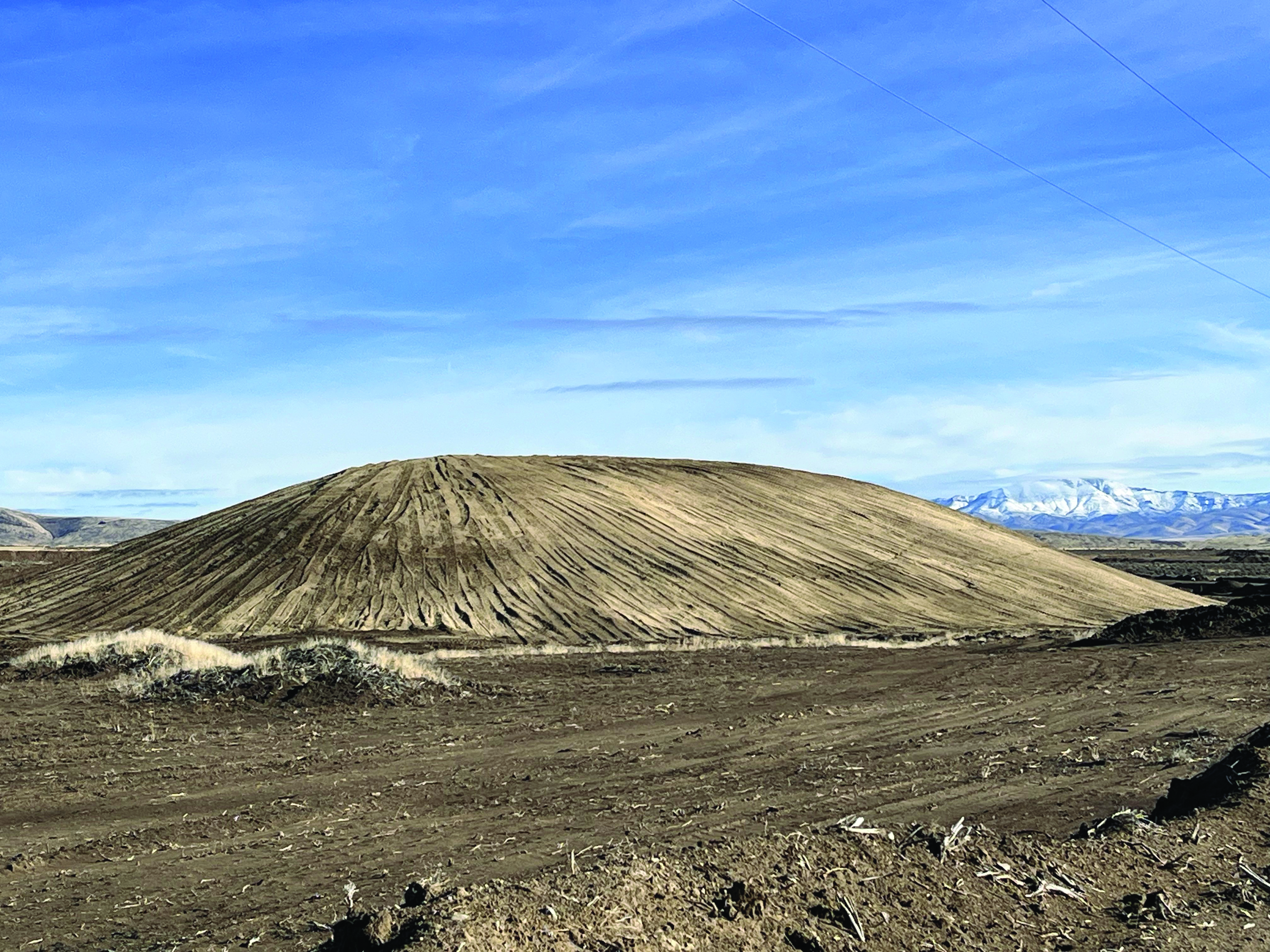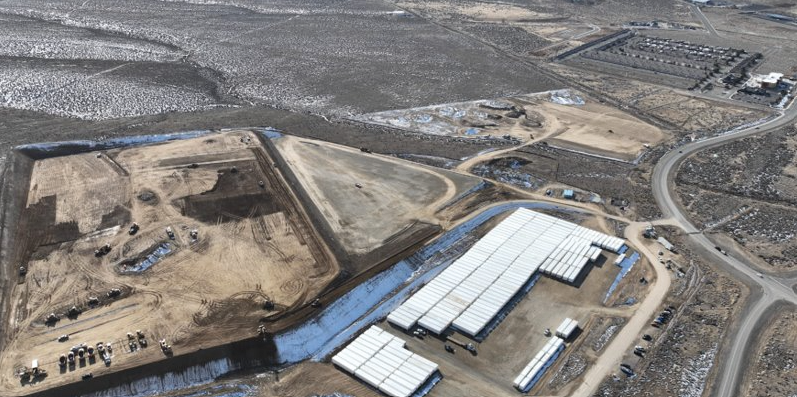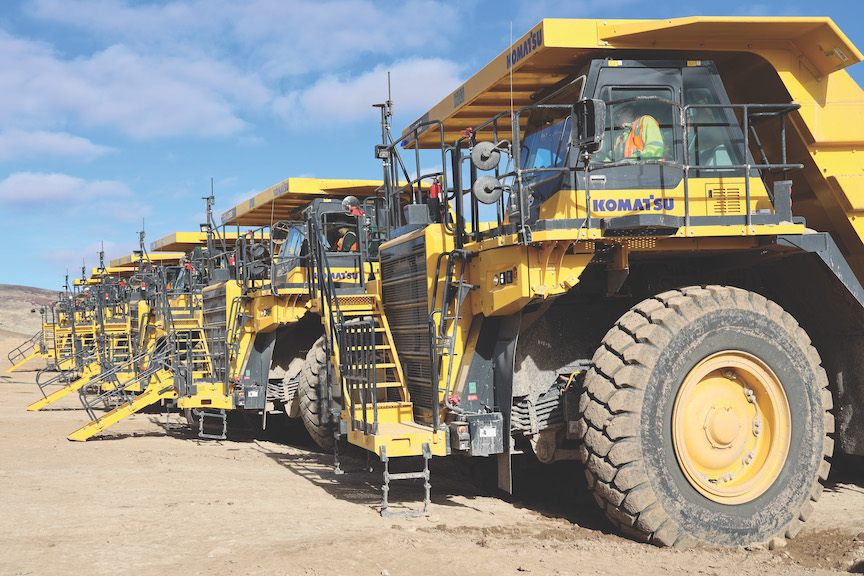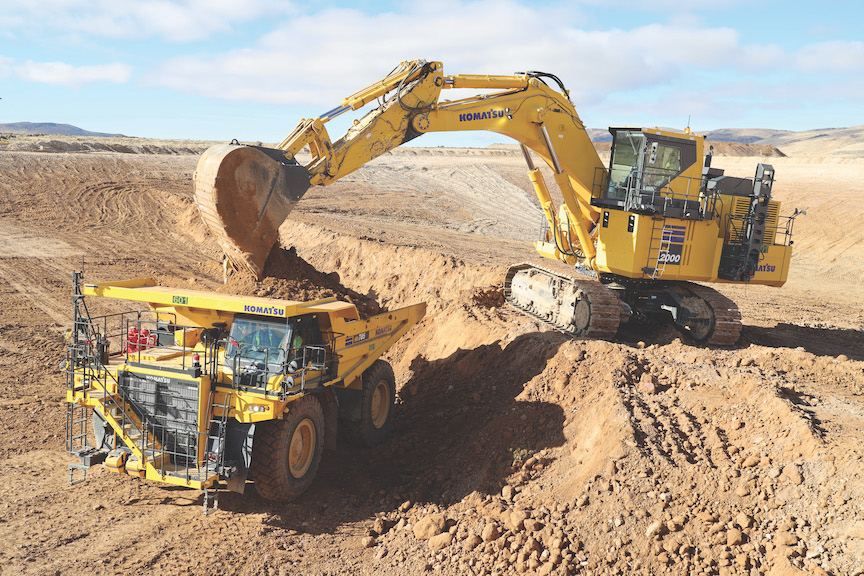Installation of the Quinn Pipeline is essential for construction at Thacker Pass to proceed, as it delivers water from our permitted production well in the Quinn River Basin to the site. The pipeline is now operational and delivering water to the construction ponds to be used for dust control. The permanent pipeline is below surface and the six-mile path where the work occurred is being reclaimed. Courtesy Lithium Americas
Construction of Nevada’s next big mine is well underway near the town of Orovada in Humboldt County.
Lithium Americas is completing initial dirt work for a massive production facility at its Thacker Pass lithium mine at the southern end of the McDermitt Caldera, which lies about 60 miles northwest of Winnemucca. Construction of the processing facilities is expected to begin in earnest once Lithium Americas closes on a $2.26 billion loan from the Department of Energy’s Advanced Technology Vehicles Manufacturing Loan Program.
Total cost of the Thacker Pass mine – the majority of which is for the processing plant – is about $3 billion, said Tim Crowley, vice president of government and external affairs for Lithium Americas. The remainder of the project is being funded through contributions made by General Motors, which gives GM an exclusive 15-year offtake agreement.

Courtesy Guy/Lithium Americas
Sawtooth Mining is the mining contractor for Thacker Pass and is working to prepare the processing plant area for construction. It has cleared the area of all topsoil and moved it to stockpiles. One of the topsoil stockpiles has already been contoured to blend in with the surrounding area, and the stockpile has been seeded with native grasses. The native grasses will help the soil stay in place for the life of the operation, making it available for reclamation to bring the area back to pre-mining land uses. Sawtooth has completed leveling of the processing plant area in preparation for foundations to be poured.
General Motors already purchased $320 million of Lithium Americas’ common shares, which represents about half of the company’s financial commitment to the company, Crowley said. GM has committed to an additional $330 million, Crowley added.
“With that money, the Department of Energy loan, and our publicly traded shares, we will have all the money needed by the end of the year to build this project,” he said.
Thacker Pass and the McDermitt Caldera
Thacker Pass contains the largest measured and indicated lithium resource in North America, Crowley told NNBW during a tour of Lithium America’s Lithium Technical Development Center on Corporate Drive in Reno. The center contains a scaled-down model of the production facility that’s to be developed at Thacker Pass and has been instrumental in developing and fine-tuning the extraction processes that will be used to turn lithium clay into lithium carbonate, a refined mineral that’s critical to the production of batteries for electric vehicles.
Currently, China accounts for roughly 70 percent of lithium processing, but the Thacker Pass mine is expected to produce enough lithium carbonate for approximately 800,000 electric vehicles each year.

Courtesy Lithium Americas
At the peak of construction, Thacker Pass will employ approximately 1,800 skilled workers. During the construction phase, the company will offer optional housing for union workers at the Workforce Hub facility in east Winnemucca. The complex will have almost 2,000 individual rooms with bathrooms, a full commercial kitchen, dining room, gym, commissary and meeting rooms.
The McDermitt Caldera is the remnants of an ancient volcano that exploded approximately 16 million years ago. It became a dry lakebed in the ensuing eons, and when the water receded it left lithium deposits that are relatively close to the surface at a maximum depth of about 350 feet, Crowley told NNBW.
The huge caldera encompasses roughly 475 square miles, or 304,000 acres. Lithium America’s mining operations are on 18,000 acres, though mining operations are expected to disturb less than 7,000 total acres of land.
Lithium Americas is permitted for a 40-year mine life at Thacker Pass. Mining operations during the first 20 years are expected to remain at that 350-foot depth, and descend to about 450 feet over the remaining 20 years, Crowley said.
Globally, lithium is typically mined from brine or hard rock, but lithium deposits in Nevada differ. Additional lithium clay mining projects in Nevada include Ioneer’s Rhyolite Ridge lithium-boron project near Tonopah, and Century Lithium’s Angel Island project in the Clayton Valley region of Esmeralda County.
A project like no other
Building the facility is a tremendous undertaking – peak construction employment is expected to top 2,000 trade workers, Crowley said.
Lithium Americas partnered with North America’s Building Trades Unions to construct the processing facility at Thacker Pass.
“Bringing that many welders, crane operators, steel fabricators, pipefitters and other trades here without union help would be very difficult,” Crowley said. “We are very glad for that union partnership.”
Lithium Americas has contracted lithium mining operations to Sawtooth Mining of Plano, Texas. Sawtooth Mining is a subsidiary of North American Coal of Dallas.
“We went with a coal miner instead of a hard rock miner because the deposit at Thacker Pass is soft, like a lignite coal,” Crowley said. “North American Coal has been our partner for several years now and has designed our mine plan, a safety plan, and a reclamation plan.”
The mining plan will be slightly different from the massive open pit gold mines in Nevada. Sawtooth Mining will employ a process called “block mining” where it excavates sections of the pit and backfills at the same time, Crowley said.

Courtesy Lithium Americas
In September 2023, six new Komatsu HD785-8 trucks were commissioned to the Thacker Pass Project. The $10 million fleet purchase will generate more than $700K in tax revenue for the State of Nevada and Humboldt County. The Komatsu HD785-8 models are rated for a 100-ton payload capacity, powered by a 1,200-horsepower engine.
“It’s concurrent reclamation,” he said. “They will go down 350 feet deep and across the width of the pit, and as soon as they have opened up enough space, they will start backfilling. The material that comes out of the pit that doesn’t contain lithium will go right back into it.
“At no point will the pit be more than 30 percent open,” he added.
Sawtooth Mining has already completed dirt work on approximately 1,000 acres to create pad spaces for the processing plant. The foundations are expected to be poured early next year, and Lithium Americas already has awarded a contract for an onsite concrete batch plant.
Vertical construction, meanwhile, is expected to consist of a series of different plants that will process the lithium clay and turn it into an end product of lithium carbonate.
Unique processing facility
Crowley said that mining is the easier part of the extraction process. The heavy lift is turning the lithium clay into lithium carbonate.
“We are basically building a chemical manufacturing plant,” he said. “It’s big. It’s not an off the shelf facility because nobody has ever mined lithium in a clay deposit.”
One of the most expensive components of the facility, Crowley said, is its onsite sulfuric acid plant. Sulfuric acid is instrumental in breaking down the molecular structure of the lithium clay.
There are multiple advantages of building the sulfuric acid plant, Crowley noted.
“Rather than importing sulfuric acid to the site, which has inherent dangers, we are going to import sulfur, which is benign,” he said. “It takes one truckload of sulfur to make three truckloads of sulfuric acid, so our transportation costs go down by two-thirds and the safety factor goes way up.”

Courtesy Lithium Americas
Thacker Pass is in the major earthworks construction phase to complete preliminary infrastructure work and prepare for the commencement of major construction in the coming year.
Heat is generated when you make sulfuric acid, Crowley added, and capturing the heat used during the manufacturing process will generate about 40 percent of the power required at the site. A power plant will be bolted onto the sulfuric acid plant.
Lithium Americas is also building a rail yard on the western edge of Winnemucca not so much for shipping lithium carbonate but for all the materials that will be coming to the site for processing lithium ore, such as sulfur, lime and fuel. It’s leased land and will create a transloading spur that ties into the Union Pacific line.
Lithium carbonate will leave the site in super sacks and likely be shipped by truck to its final destination; however, it may also leave Nevada by rail.
“Because we will own that railyard, if it makes more sense to put our finished product on a train to get it to a cathode manufacturing plant then that’s what we will do,” Crowley said.
Decades-long journey
When lithium mining commences at Thacker Pass, it will mark the culmination of a decades-long journey.
Crowley told NNBW that Chevron was searching for uranium in the McDermitt Caldera in the 70s and found lithium, but at the time there was no real market for the commodity. Western Uranium, which rebranded as Western Lithium, began exploration drilling in the late 2000s. In 2015, Western Lithium merged with Lithium Americas.
Once mining commences, Lithium Americas will continue to run its test plant at the Lithium Technical Development Center in Reno to optimize mining processes.
“As you move through your ore body, it's not the same,” Crowley said. “The clay is different as you move, so how you leach and process it changes.
“It’s really hard to do a project like this,” he added. “It’s expensive, it has to be done right, and there’s no set timelines on when you can go from one step to the next. It’s taken us well over a decade to get to where we are today, and we still have a three-year construction phase before we make our first dollar. We have been operating on borrowed money for a long time, and we are operating on public land, which requires a high level of public engagement and environmental stewardship.”
 Tim Crowley
Tim Crowley